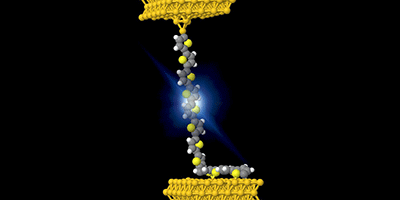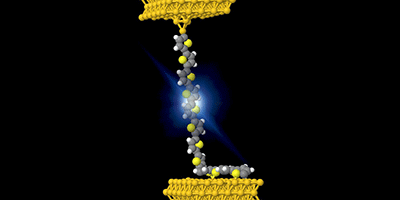A Single-Molecule Light-Emitting Diode
Transforming electrical current into light is critical for technologies such as telecommunications and displays. In Physical Review Letters, researchers report luminescence from a single polymer molecule, representing the smallest possible organic light-emitting diode (OLED) device.
To electrically connect to an individual polymer molecule, Gaël Reecht of the University of Strasbourg, France, and his colleagues used a gold-coated scanning tunneling microscope tip to identify and then grab one end of a single polythiophene molecule lying on a gold substrate. When they pulled back the tip and applied a voltage, they measured a nanoampere-scale electrical current running between the tip and substrate through the polymer, which was held at just a few kelvins. As long as the voltage was large enough, the energy spectrum of the emitted light didn’t change, leading the researchers to conclude the light emerges when electrons jump between intrinsic energy levels of the polymer, not those of the metal electrodes.
Still, the light emission was strongly enhanced by the sloshing it generated in nearby electrons in the gold tip and surface. When the tip had a large negative voltage, a photon emerged for every electrons that entered the molecule from the tip. But with the opposite polarity, the team suggests that the molecule’s stronger electrical connection to the substrate keeps the relevant molecular level too high in energy to be populated from that side. The observed -fold asymmetry is reminiscent of that in commercial OLED devices, but on a vastly smaller scale. – Don Monroe





